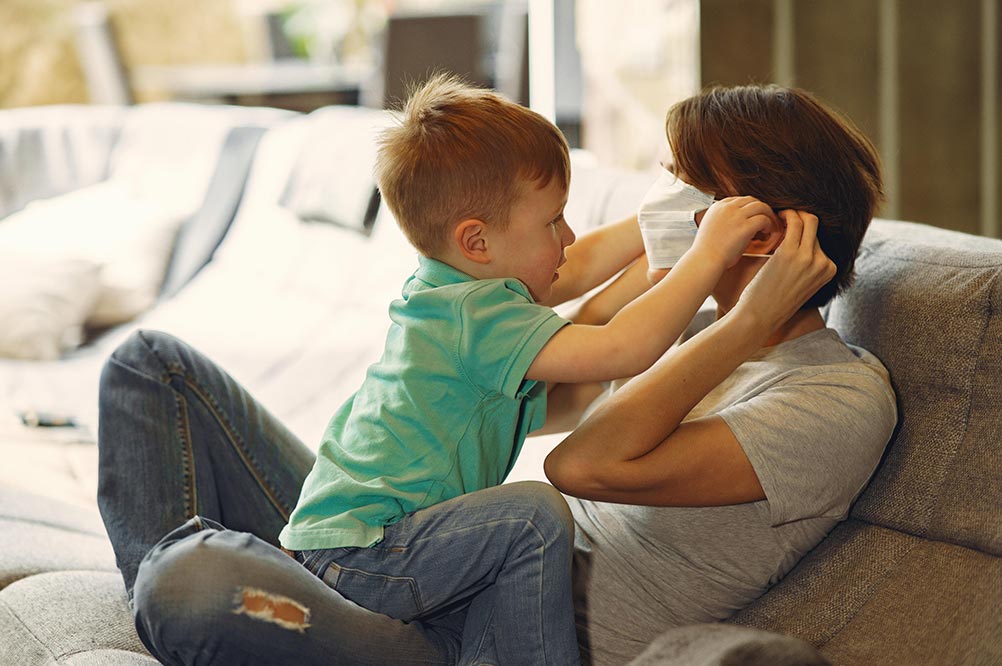Helping kids adjust to wearing face masks
Written by Lourdes Bruwer, Carly Tzanos and Claire Toi | Early Childhood Development experts
Tags: ChildcareSafetyPsychologySensory Perception
Are you wondering how to navigate your way around face masks with your child?
As we continue to take precautions against the spread of the COVID-19 virus, it has now become mandatory to wear face masks when leaving home.
Although it is strongly advised against the use of face masks for under 2-year-olds, older toddlers and children must wear cloth masks when out and about.
This is our new normal and while children may be better at adjusting to new routines than us adults, for some sensitive little ones this new normal can pose a challenge.
Children have sensory systems that are still developing
How easy has it been for you as an adult to don a face mask and then not touch your face or adjust your mask while you are away from home? Children, who have limited impulse control, will find this task a big ask!
For mature sensory systems, a sensory stimulus that remains unchanged gets filtered out. For instance, one may feel glasses or a scarf when first putting it on, but before long our clever sensory system blocks out this background sensory information to free up the brain for more important incoming sensory input.
For our children whose sensory systems are still developing, this may not be the case. Their sensory system may find it hard to block out background sensory information, making it almost impossible for them to get used to the mask and thus keep it on.
Even what we see is filtered out after a while. For us adults, we may not see the edge of the mask just below our eyes after a little while just like we don’t see the frames of our glasses once we have them on. However, a sensory sensitive child whose sensory system is still maturing may not be as adept to filtering out this unimportant visual input.
Children are also still learning how to read other people’s facial cues. Now, having other people’s faces half covered by masks makes this task even more difficult for our little ones which can invoke anxiety for them. A child who is smell sensitive may struggle to deal with the smell of the mask right up against their very sensitive nose.
It’s no wonder our little people may be struggling to adjust!
Nubabi’s Occupational Therapists, Lourdes Bruwer and Carly Tzanos and Clinical Psychologist, Claire Toi have compiled some insights and advice to help you find an acceptable option for both you and your child when navigating your way around these new challenges.
Talk about it
Small children understand so much more than we often give them credit for. They have noticed a lot of change lately and will be missing what they are accustomed to.
Sharing information with them helps lessen anxiety and can even empower them in their decision-making. Tailor what you say to match your child’s developmental level and talk to them about what their mask is for - “It’s to keep our bodies healthy and strong! We have tiny germs all around us and most are really friendly and good for us, but a few can make us sick. So we use our masks like a door or shield to keep the outside germs outside.”
Model the right behaviour
We sometimes forget that so much of what children learn is based on watching what others do. Parents and caregivers are very powerful role models and modelling wearing a mask correctly with an appropriate attitude can be very helpful.
Narrate what you are doing in concrete terms - “mask over nose, mask over mouth, elastic behind ears/head”.
Select your mask carefully
If you’re able to, try various options and ask your little one for some feedback. When children are involved in the choice-making process, they tend to have better buy-in and better participation. While giving them some creative freedom, you will need to ensure the fabrics used are breathable.
The Fit
Think about the physical design of the mask, especially how it hooks around the ears or straps behind the head as different children will prefer different things.
There are many touch receptors in and around the face, and having a mask hooked onto little ears can be very annoying for sensitive ears. You could try sewing a button onto a favourite cap or hat so that the mask doesn’t hook onto the ears or you could make a strap with buttons for the back of the head to avoid having to hook the mask onto little ears.
There are many touch receptors in and around the face, and having a mask hooked onto little ears can be very annoying for sensitive ears. You could try sewing a button onto a favourite cap or hat so that the mask doesn’t hook onto the ears or you could make a strap with buttons for the back of the head to avoid having to hook the mask onto little ears.
Deep pressure is your friend so a firmer tighter mask will be easier for a sensory sensitive child to tolerate than a light and flimsy or loose-fitting mask.
The Fabric
The type of material should also be considered. Perhaps a busy pattern or alerting colour for the mask is not a great idea as the mask is close to the eyes which can be visually overwhelming.
Use soft fabric for sensitive children. You could use familiar fabric for example fabric from an old favourite pair of pyjamas or special blanket etc. Be cognisant of the detergent used when washing the mask. Try to use fragrance-free detergent where possible.
Alternatives
If all else fails and your little one just cannot get used to the mask, consider alternatives such as a face shield or a shield sewn onto a hat almost like a beekeeper hat.

Make it playful
Children have a wild sense of imagination - so use this to your advantage! Make it into a game - you could pretend they are wearing a Ninja mask!
Social stories are also a wonderful way to explain the need for the mask and to highlight the importance of it for little ones. You could make up your own story using your own child’s pictures and names for the story.
A child’s work is to play, and there is no better way to get your little one used to a new routine than by playing it out first. So get roleplaying with teddy learning to wear a mask first!
You can also have your child be a doctor/nurse with their toys or even with you. Let him “teach” you how to put on the mask and if they are able, explain to you why you are wearing it. Games and engagements like these all help our little ones to process what wearing a mask is about and make sense of it.
First practice at home
Children manage better when there is routine, so try to involve specific routines around the mask-wearing.
Try including a few simple hand signals into these routines seeing as everyone’s faces are half-covered (e.g. thumbs up/down).
Singing can be very calming and can be a helpful tool as a means of distraction while putting a mask on. You would just need to make sure it’s on by the end of the song!
Play a game and challenge your little one to spot the problem by making mistakes when you put your mask on. For example, don’t cover your mouth, or leave your nose sticking out. Be extra silly and put it on the back of your head or on top!
The silliness can help dissipate tension that may have developed around the use of a mask - so have some creative fun! Lots of cheering when you get it right.
When out and about
Keep little hands busy
Busy hands are less likely to touch little faces, so try to plan for how you can keep your little one from touching his face while out and about with the mask on. Just remember that any item you consider needs to be easily cleanable.
Here are some ideas:
- You could give your little one an elastic band to tug on, a pipe cleaner to fidget with, a piece of putty or play dough to fidget with, a paper clip to unwind, bubble wrap to pop etc.
- Making a little balloon stress ball by filling a double-layered balloon with flour can be a great fidget toy.
- Fidget spinners and fidget cubes can keep little fingers clicking and moving and away from faces!
Ground their sensory system
Provide your little one with extra-sensory calming to help him tolerate the new sensory input from the mask.
Here’s how:
- The mouth is a very calming and soothing organ, so possibly sucking a sweet or chewing gum for the older child who could manage that while wearing a mask for some extra sensory soothing without having to remove the mask in between is a good idea.
- You could include daily massages or body brushing to your child’s routine to get some extra sensory soothing in. After a bath, use rough towelling to give his skin a heavy dose of sensory calming deep pressure.
Celebrating effort
Mask usage should be balanced carefully with your little one’s growing need for autonomy. Ideally, you would be working on patiently and gently acclimatising your child to more extended periods of mask-wearing. If this were to be rushed and become a battle of wills, it could lead to a lot of mixed messages being sent, including whether your little one has autonomy over what happens to their own body.
For many children, the reward for wearing their mask is the outing that goes along with it, but some will require extra motivation.
Should you use a star chart? This kind of external motivation only works for a small subsection of children and then, for some of those children, only for a limited amount of time. The reason for this is that an external motivator is rarely as powerful as internal motivation.
It may be more effective to build your child’s own motivation by giving them information, giving them choices (design, fit, fabric type), and being consistent in your interactions (being firm and gentle vs threats or bribes).
Celebrate the wins! Definitely consider celebrating a child who is having a difficult time wearing a mask, but perseveres. Including your little one in selecting their reward activity may be just the motivation they need.
It is a challenging time for all, so try to remember to be patient, with your little ones as they learn to adjust and with yourself as you help them in their way.
Stay safe. Stay healthy.
Share this
- 0
- 1
Related Posts
Have you tried the Nubabi Free Trial?
Get unlimited access to Your Parenting Toolkit for 2 weeks for free!
Track, Boost, Explore and Capture your child's growth and development.
Available on both mobile and web.


